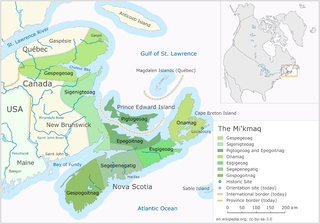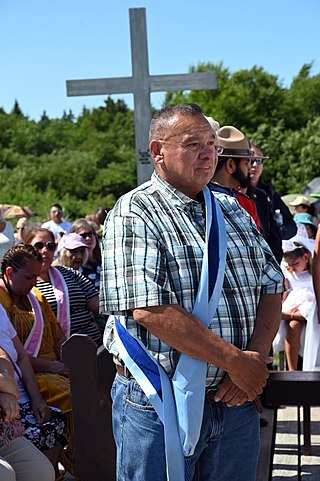Related Research Articles

The Mi'kmaq are an Indigenous group of people of the Northeastern Woodlands, native to the areas of Canada's Atlantic Provinces, primarily Nova Scotia, New Brunswick, Prince Edward Island, and Newfoundland, and the Gaspé Peninsula of Quebec as well as Native Americans in the northeastern region of Maine. The traditional national territory of the Mi'kmaq is named Mi'kma'ki.

Cape Breton Regional Municipality is the Canadian province of Nova Scotia's second largest municipality and the economic heart of Cape Breton Island. As of 2021 the municipality has a population of 93,694. The municipality was created in 1995 through the amalgamation of eight municipalities located in Cape Breton County.

The Listuguj Mi'gmaq First Nation is a Mi'gmaq First Nations band government with a registered population (2022) of 4,248 members, most of whom are of Mi'kmaq ancestry. The name Listuguj, is the origin for the name of the Restigouche River, as well as other nearby places also carrying the name Restigouche. Listuguj is also used as a name for one of the Míkmaq orthographies. Its southern border is adjacent to Pointe-à-la-Croix, Quebec.
Rita Joe, was a Mi'kmaq poet and songwriter, often referred to as the Poet Laureate of the Mi'kmaq people.
The Membertou First Nation is a Mi'kmaq First Nation band government in the tribal district of Unama'ki, also known as Cape Breton Island, Nova Scotia. As of 2012, the Mi'kmaq population is 814 on-Reserve, and approximately 481 off-Reserve. It operates a community radio station CJIJ-FM. Currently, Membertou has become the most well-off First Nation in Atlantic Canada.
Noel Joseph JeddoreWe’jitu also Newell Jeddore Gietol, Geodol was Saqamaw "grand chief" of the Mi'kmaq at Miawpukek in Bay d'Espoir on the south coast of Newfoundland in the Coast of Islands region. Jeddore served as chief from July 26, 1919 until he was forced into exile to Eskasoni, Nova Scotia, in 1924. He was born at Indian Point, Bay d'Espoir and he died at Eskasoni, Cape Breton.
The Unama'ki Institute of Natural Resources (UINR) is an Indigenous led non-profit organization located in the Mi'kmaw community of Eskasoni on Unama’ki, Nova Scotia, Canada.

Mi'kma'ki or Mi'gma'gi is composed of the traditional and current territories, or country, of the Mi'kmaq people, in what is now Nova Scotia, New Brunswick and eastern Quebec, Canada. It is shared by an inter-Nation forum among Mi'kmaq First Nations and is divided into seven geographical and traditional districts with Taqamkuk being separately represented as an eighth district, formerly joined with Unama'ki. Mi'kma'ki and the Mi'kmaw Nation are one of the confederated entities within the Wabanaki Confederacy.

The Sipekne'katik First Nation is composed of four Mi'kmaq First Nation reserves located in central Nova Scotia. As of 2012, the Mi'kmaq population is 1,195 on-Reserve, and approximately 1,190 off-Reserve. The First Nation includes Indian Brook 14, Nova Scotia, near Shubenacadie, Nova Scotia. The band was known as the Shubenacadie First Nation until 2014 when the traditional spelling and pronunciation of its name was officially adopted.
Paqtnkek Mi’kmaw Nation is a Mi'kmaq Band in northeastern Nova Scotia. Its populated reserve is Paqtnkek-Niktuek 23. As of December 2019 the total registered population was 598. It is a member of the Confederacy of Mainland Mi'kmaq. The name Paqtnkek means “by the bay” or "Above the water ". The area has long been important to Mi'kmaq for the fishing of eel and other species.

Gabriel Sylliboy was the first Mi'kmaq elected as Grand Chief (1919) and the first to fight for the recognition by the state of Canada of the treaties between the government and the First Nations people.
Ursula Johnson is a multidisciplinary Mi’kmaq artist based in Halifax, Nova Scotia, Canada. Her work combines the Mi’kmaq tradition of basket weaving with sculpture, installation, and performance art. In all its manifestations her work operates as didactic intervention, seeking to both confront and educate her viewers about issues of identity, colonial history, tradition, and cultural practice. In 2017, she won the Sobey Art Award.

The Mi'kmaq–Nova Scotia–Canada Tripartite Forum was established in 1997 to provide the Mi'kmaq, Nova Scotia, and Canada a place to resolve issues of mutual concern. The Forum's vision is to develop Mi'kmaw communities and foster positive relationships with other Nova Scotians.
Marie Ann Battiste is an author and educator working as a professor in Canada at the University of Saskatchewan in the Department of Educational Foundations. From the Potlotek First Nation in Nova Scotia, Battiste is the daughter of Mi'kmaq parents John and Annie Battiste and is one of four children. Battiste was raised in Houlton, Maine, where she attended high school graduating in 1967. From there she went on to the University of Maine graduating from the Farmington campus in 1971 with her teaching certificate and a bachelor of science in both elementary and junior high education. She went on to attend Harvard University graduating in 1974 with a master of education in administration and social policy as well as Stanford University, where in 1984 she graduated with a doctor of education in curriculum and teacher education.

The Peace and Friendship Treaties were a series of written documents that Britain signed bearing the Authority of Great Britain between 1725 and 1779 with various Mi’kmaq, Wolastoqiyik (Maliseet), Abenaki, Penobscot, and Passamaquoddy peoples living in parts of what are now the Maritimes and Gaspé region in Canada and the northeastern United States. Primarily negotiated to reaffirm the peace after periods of war and to facilitate trade, these treaties remain in effect to this day.
Benjamin Kji Saqamaw Sylliboy was a Grand Chief of the Miꞌkmaq who lived at the We’koqma’q First Nation in Cape Breton, Nova Scotia, Canada. He served as Grand Chief for 25 years from 1992 until his death in 2017.

Norman Sylliboy is the 11th Grand Chief or Kji-Saqmaw of the Mi'kmaq Nation. The Mi’kmaq traditional government is known as Sante' Mawio’mi or Grand Council.
Alexander Denny, otherwise known as Kji-keptin Alex Denny of the Mi'kmaq Grand Council, both a founding member and two-term president of the UNSI, was most prominently known for the role he played in the ongoing battle for recognition of Mi'kmaq treaties and Indigenous rights. Born to the Eskasoni First Nation and raised by two elders in the community, Denny was taught the importance of Mi'kmaq treaties from a young age. His passion for and knowledge of his community ultimately led Denny to be credited with attaining linguistic and political rights for the Mi'kmaq at an international level. Additionally, It was Denny and the UNSI that organized the very first Treaty Day.
Two-Eyed Seeing is a basis in viewing the world through both Western and Indigenous knowledges and worldviews. Two-Eyed Seeing was introduced by Mi’kmaq Elders, Albert D. Marshall and Murdena Marshall from Eskasoni First Nation, alongside Cape Breton University (CBU) professor, Cheryl Bartlett. Albert Marshall describes Two-Eyed Seeing as an approach to viewing the world "from one eye with the strengths of Indigenous ways of knowing, and to see from the other eye with the strengths of Western ways of knowing, and to use both of these eyes together". Two-Eyed Seeing was originally brought forward as a tactic to encourage Mi'kmaq university students to pursue an education in science. Since its implementation, the use of Two-Eyed Seeing has been integrated into various institutions' strategic plans, government policies, and research, some of which include the Canadian Institute of Health Research.

Murdena Marie Marshall was a Mi'kmaw elder, language speaker, knowledge keeper, Traditional Knowledge expert, spiritual leader, author, and associate professor of Mi’kmaw Studies at Cape Breton University. Along with her husband Albert Marshall and biologist Cheryl Bartlett, Marshall is recognized as the co-creator of the influential two-eyed seeing research methodology, a methodology now used extensively within Canada, particularly within science and health. Marshall received numerous awards and honors, including an honorary Doctors of Letters, honoris causa, from Cape Breton University in 2009 in recognition of her role in promoting and supporting Mi’kmaw culture and education. A strong advocate for education, several scholarships and awards have been created in her name, including the Murdena Marshall Science Award, and the Murdena and Albert Marshall Bursary at Dalhousie University.
References
- ↑ "First Nation Detail". Crown–Indigenous Relations and Northern Affairs Canada . Government of Canada. Retrieved December 28, 2019.
- ↑ "First Nation Detail". Crown–Indigenous Relations and Northern Affairs Canada . Government of Canada. Retrieved December 28, 2019.
- ↑ "First Nation Detail". Crown–Indigenous Relations and Northern Affairs Canada . Government of Canada. Retrieved December 28, 2019.
- ↑ "First Nation Detail". Crown–Indigenous Relations and Northern Affairs Canada . Government of Canada. Retrieved December 28, 2019.
- ↑ Branch, Government of Canada; Indigenous and Northern Affairs Canada; Communications (November 3, 2008). "Home". Crown–Indigenous Relations and Northern Affairs Canada . Government of Canada. Retrieved March 17, 2021.
{{cite web}}: CS1 maint: multiple names: authors list (link) - ↑ "No need of a chief for this band" (PDF). UBC Press. Retrieved March 17, 2021.
- ↑ Government of Canada (January 15, 2008). "2006 Aboriginal Population Profile". www12.statcan.gc.ca. Statistics Canada. Retrieved March 17, 2021.
- ↑ "Eskasoni First Nation" (PDF). Dalhousie University. Retrieved March 17, 2021.
- ↑ Roache, Trina (April 10, 2020). "Uprooted: The little known story about Mi'kmaw history of forced relocation". APTN News. Retrieved March 17, 2021.
- ↑ Network, SaltWire. "Cape Breton doctor to be honoured". Cape Breton Post.
- ↑ "Respected physician says First Nation needs the land 'more than I do'". www.mmnn.ca. Mi’kmaq-Maliseet Nations News. Retrieved March 17, 2021.
- ↑ "History of Eskasoni". www.eskasoni.ca. Retrieved March 17, 2021.
